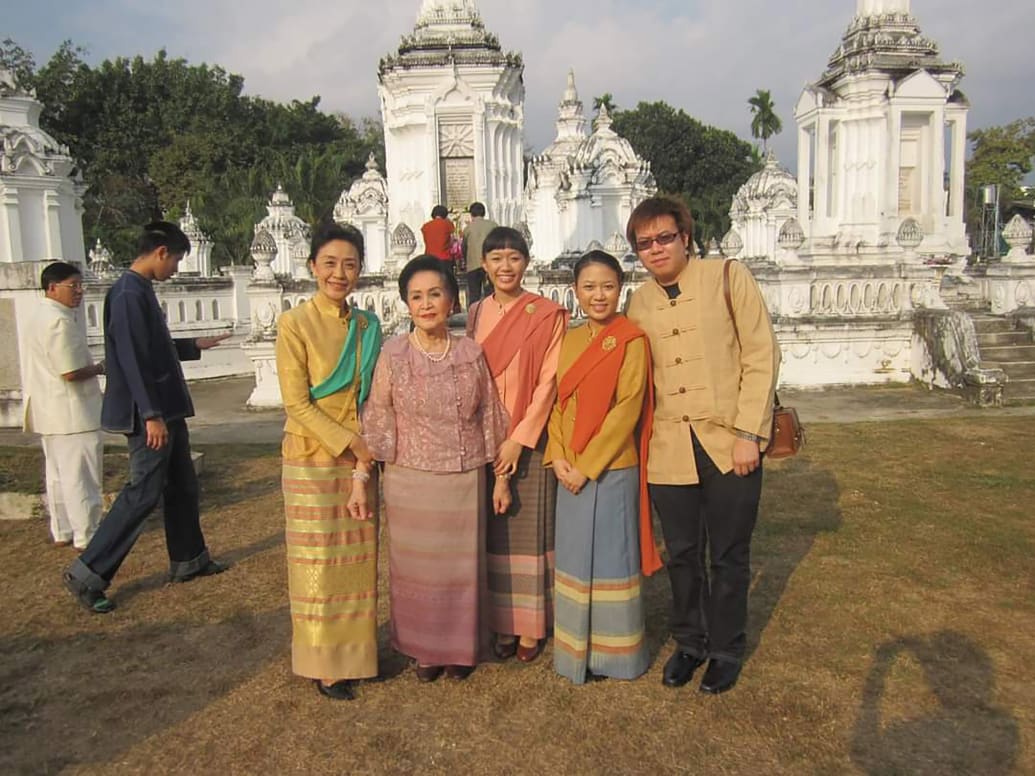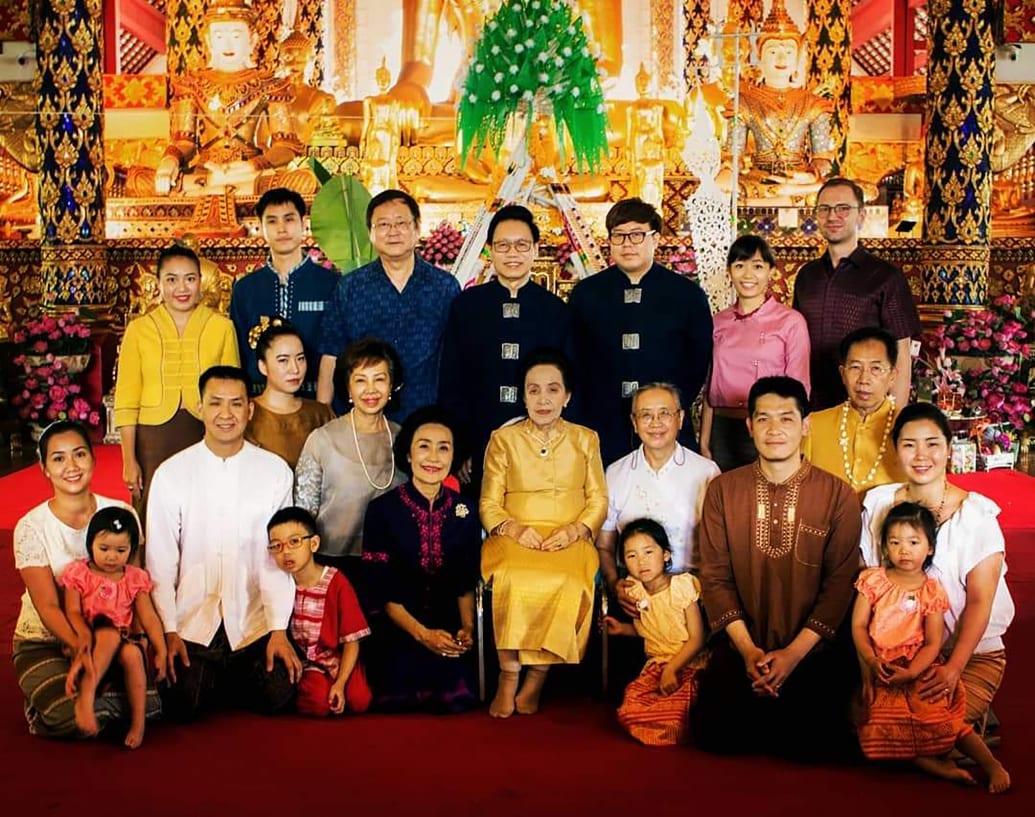The last Lanna princess, who died last month, was only 10 when her kingdom was abolished. But what she did after that was nothing short of majestic.
CHIANG MAI, Thailand—The funeral of Chao Duang Duen Na Chiang Mai, the last princess of the now dissolved Lanna Kingdom of Northern Thailand, was just as grandiose as the extraordinary life she led.
“It’s a funeral?” one onlooking traveler asks, “why are they wearing white?” Lanna don’t wear black and Saturday was the last day of a week-long, Lanna last rites ceremony. The Abbot had blessed the coffin, now nestled in a small mobile “castle” ready to be led in procession by alms bearers, an elephant, hundreds of Fon Lep nail dancers, tangerine monks and family of the deceased.
Chao Duang Duen died aged 93 on Jan. 2, at her home in Chiang Mai, the capital city of the lands of her forefathers. Established in 1292 AD, the Lan Na kings ruled a wide, mountainous region of what is now Northern Thailand for 500 years—before being annexed by Siam, the expanding dominion to the south. Distinguished by their own language, arts, culture, animistic beliefs and Buddhist traditions, Lanna lands became tributary states, their kingdom split into smaller principalities. That rolled along until 1939 when Duang Duen’s grandfather, King Kaew Nawarat died, and the Lanna royalty was completely abolished by Siam. Duang Duen was only 10 years old.

Courtesy of Chaoduangduen.com
Eighty years later, Thailand remembers Chao Duang Duen as a cultural patron, but for the people in the vast province of Chiang Mai, she was more than that. From the thousands of mourners at her funeral, to the language and reverence locals use when discussing her, it’s clear that she was still their princess.
“You can inherit the title, but you don’t inherit respect. She worked for that,” her granddaughter, Loogtan Yontaranak, told The Daily Beast while walking us through an exhibition on Duang Duen’s life. The photographs, trophies and awards, costumes and testimonies have their own pavilion in Wat Phra Singh temple for the week of the funeral.
“Her way of being a princess was the way she cared for other people,” her grandson Pana Yontaranak said. He told The Daily Beast how, throughout his grandmother’s life, she used savvy business acumen, devotion to Lanna culture and socio-political diplomacy to better the lives of people in both rural and urban Chiang Mai.

Courtesy of grandson Pana Yontaranak
Most of Chao Duang Duen’s descendants work in the arts. Yontaranak is a piano teacher and lecturer. His parents, including Duang Duen’s daughter Sugar and son-in-law Nat founded a much loved concert hall in Bangkok, Sala Sudasiri Sobha. A natural lineage, given the late princess’ background as an accomplished dancer, musician and performer. She practiced throughout her life, and in 1972, even danced Fon Lep for King Rama IX, his wife Queen Sikirit and Queen Elizabeth II of the United Kingdom on a state visit to Chiang Mai.
Duang Duen was raised by Princess Bua Tip, the daughter of that last Lanna ruler, King Kaew Nawarat, in the royal palaces of Chiang Mai. Bua Tip was a great patron of the arts and Duang Duen describes her young life at court as one of theatrical plays and music recitals, where she herself also trained in traditional Lanna arts, as nobles’ daughters led performances for visiting dignitaries. She and her three siblings lived in a colossal teak-wood palace on the Ping River in Chiang Mai, which was destroyed in the 1940s to make way for Nawarat Market. The developers had the good grace to name the market after the last king.
Three Rules
Pana reveals that following the dissolution of the Lanna princely line, Duang Duen’s father, Chao Ratchaphakinai, distributed plots of the erstwhile royal family’s land to his staff and farmers entirely for free, so they could continue to live and work safely. This philanthropy made a great impression on the young princess, who continued to live in Chiang Mai for her entire life, even after her siblings and wider family moved south to Bangkok.
Among her first steps into public life, following her marriage to local MP Pirun Intrawut, was the launch of her own newspaper, The Voice of Chiang Mai. She also hosted local radio shows, winning the prestigious Voice of America Medal for exemplary broadcasters. She was known for her sharp mind, and “always reading, always learning, making us watch the news instead of cartoons as kids,” Pana recalls.
After establishing herself as a critical voice to be reckoned with in the local media, Chao Duang Duen studied to become the first female judge of the Juvenile Court in 1970, before she was voted into the House of Representatives, part of Thailand’s National Legislative Assembly, in 1973.
“She didn’t stop working at all.”
“People ask me, how come your grandmother was so modernized?,” laughs Pana. She used her platform to promote women’s rights, campaigning for birth control to be adopted in the region, and leading the local Family Planning Association of Thailand. She went on to form the Northern Association of Women Entrepreneurs, encouraging women to get into the workplace. “In her speech when launching that association,” Pana says, “she said that firstly you have to be a good person. That’s the most important thing. Secondly, you have to be wise. Thirdly, you have to look great. And the final thing, you have to love your country and your people.”

Courtesy of grandson Pana Yontaranak
After being a journalist, judge and women’s rights campaigner, her final metamorphosis saw Chao Duang Duen take on the role of protector of Lanna arts, cleverly preserving her culture while creating jobs that equated to economic stability for people in rural and suburban Chiang Mai.
She founded the annual Chiang Mai Flower Festival in the 1970s, which still takes place every February. But more impactful still, in the 1980s she launched her own textiles brand, Duang Duen Cotton, opening factories and employing women from the villages surrounding Chiang Mai, preserving traditional Lanna weaving patterns and natural dyeing methods.
“She came at the right time and became a springboard for reviving Lanna culture,” Pana muses. “Her textile factory used to be a resort. She employed and trained villagers to weave textiles, this was in the late 1980s when others her age would have retired. She didn’t stop working at all.”
The factory neighbors her country residence in Jomthong; it’s since been sold on and is now called the Jomthong Native Handicraft Training Center. More visible to visitors, though, is the Chiang Mai Walking Street, which she initiated in the 1990s. Night markets and walking streets are now synonymous with Thailand, but she piloted the earliest incarnation, knocking on doors, encouraging locals to get behind it. The weekly market is a sprawling event to this day, giving hill tribe villagers and farmers a place to sell their crafts and produce.
Final Farewell
The silence of the funeral is interrupted by a somber drumbeat directing a woodwind band, which in turn guides 400 dancers. They flex then point their hands, adorned with six-inch, solid silver nails shining on every finger tip. Their sharp talons slice through the palpable tension, their dance the only movement here as everyone watches and waits. Even the confused tourists stand hushed, clustered in the temple forecourt. Wat Phra Singh is a popular sightseeing spot, as well as Chiang Mai’s royal temple. As the ranat ek Thai xylophone chimes, the entire abbey of Buddhist monks arrive, bright orange robes filing from every corner of this priory, ready to escort a coffin on a royal funeral the likes of which haven’t been seen in this city for generations.

Courtesy of grandson Pana Yontaranak
Her awards and accolades go on, but the behemothic funeral was the greatest proof of her devotion to Chiang Mai, as Chiang Mai poured love back in her moving send off. Police and traffic wardens blocked the streets of the old city center as the mile long procession of monks, Fon Lep dancers, an elephant, musicians and her extended family and loved ones slowly paced past.
After the two-hour march, her coffin arrived in Wat Suan Dok, the temple that has served as the resting place for Lanna kings for 700 years. Thousands of attendees, dressed in white, gathered to say their goodbyes to their princess as the pyre flamed—the last Lanna funeral the country will ever see.



Recommended Comments
There are no comments to display.
Join the conversation
You can post now and register later. If you have an account, sign in now to post with your account.
Note: Your post will require moderator approval before it will be visible.